![]()
![]()
![]()
Use LEFT and RIGHT arrow keys to navigate between flashcards;
Use UP and DOWN arrow keys to flip the card;
H to show hint;
A reads text to speech;
46 Cards in this Set
- Front
- Back
- 3rd side (hint)
|
Testing water for coliform
Presumptive test |
- lactose Durham tubes are used to determine mpn(most probable number)
Yellow= positive lactose fermentation
|
|
|
|
Testing for water coliform
Confirmed test
|
Emb plate to check for gram negative lactose fermenters
Pink=growth
|
|
|
|
Testing water for coliforms Completed test |
Gram staining to confirm that the cell are negative bacilli |
|
|
|
Why not test for pathogen directly? |
-coliforms are more numerous than pathogen
-coliform are easier to culture in lab than pathogen |
|
|
|
Microbes in food and water? |
Microorganism are ubiquitous Food and water must be continuously monitored for micro contamination to prevent human illness Water is monitored for coliform |
|
|
|
Coliform are? |
-G negative bacilli
-Lactose fermenters -do not produce endospores
-normal flora enterobacteriaceae (In human intestine)
|
|
|
|
Protozoa
Phylum ciliata
|
Moves using (cillia) Balantidium coli (dangerous)
Paramecium (non dangerous)
|
|
|
|
Phylum ciliata
Balantidium coli?
|
-bean shaped or bar shaped nucleus
-cause diarrhea |
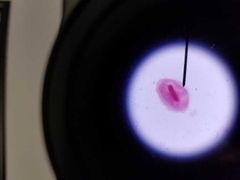
|
|
|
Phylum cilliata
Paramecium app
|
Free living
Sexual reproduction( conjugation)
Asexual reproduction(binary fission) |
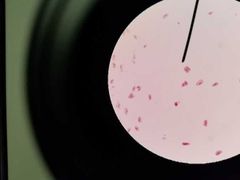
|
|
|
Protozoa
Phylum amoebozoa
|
Moves using (pseudopod)
Entamoeba histolytica( dangerous)
Amoeba proteus( non dangerous)
|
|
|
|
Phylum amoebozoa Entamoeba histolytica |
Oval shaped Ring with a dot inside Causes diarrhea |
|
|
|
Phylum amoebozoa Amoeba proteus |
Visible pseudopods Free living= no disease |
|
|
|
Protozoa Phylum archaezoa |
Moves using visible flagella Trichomonas vaginalis(dangerous) Giardia lamlia( dangerous) |
|
|
|
Phylum archaezoa Trichomonas vaginalis |
-Big round organism with a dense nucleus and flagella hanging off Causes trichomoniasis/vaginitis |
|
|
|
Phylum archaezoa Giardia lamblia |
Tear drop shape Two nuclei and multiple flagella hanging off Causes diarrhea |
|
|
|
Protozoa Phylum euglenazoa |
Moves using hidden flagella Trypanosoma (dangerous) Euglena (non dangerous) |
|
|
|
Phylum euglenazoa Trypanosoma brucei |
S shaped squiggles among rbc Causes African sleeping sickness |
Look for red blood cell |
|
|
Phylum euglenazoa Euglena spp |
Thin torpedo shaped organism Free living and photosynthetic |
Bio 105 leaf microscope |
|
|
Protozoa Phylum apicomplexa |
No mobility Plasmodium (dangerous) |
|
|
|
Phylum apicomplexa
Plasmodium spp |
Ring like organism inside rbcs
Causes malaria |
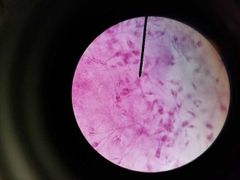
|
|
|
Microscopic fungi |
Yeast(unicellular)-round or oval
Molds(multicellularcomposed of hyphae Uses spore for reproduction |
|
|
|
Microscopic fungi
Penicillium Aspergillus
Aspergillus
|
Spore bearing structure=conidia(naked/exposed)
|
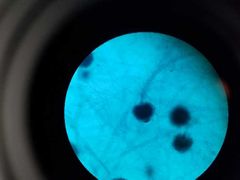
|
|
|
Microscopic fungi
Rhizopus |
Spore bearing structure=sporangium (spores encased in an outer covering) |
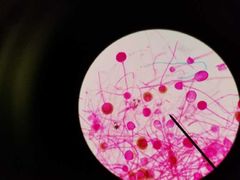
|
|
|
Helminths Monoecious? Dioecious? |
Monoecious-both Male and female reproductive organs in the same individual Dioecious-Male and female are separate individual |
|
|
|
Helminths
Platyhelminths-->trematodes 1st |
Clonorchis sinensis(liver fluke) (Monoecious) |
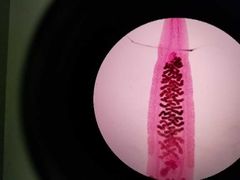
|
|
|
Helminths
Platyhelminths--> trenatodes
2nd
|
Schistosoma mansoni(dioescious) |
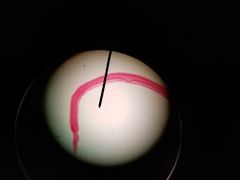
|
|
|
Platyhelminths--> cestode
2nd |
Taenia pisiformis |

|
|
|
Helminths Nematodes |
Trichinella spiralis |
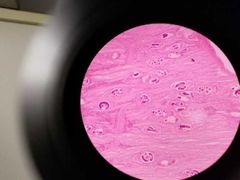
|
|
|
Microbe if urinary tract |
-Considered sterile bodily fluid out -there is normal flora in the human bladder -when bacteria is cultured we assume that they are pathogen |
|
|
|
Quantitative analysis |
Determine the number of bacteria per ml of urine |
|
|
|
Qualitative analysis |
Examine the feature of bacteria that grow in urine |
|
|
|
Cariogenic bacteria |
-Bacteria that can lead to tooth decay and dental Carrie's(cavities) -Product capsule-> stick to teeth -Ferment sugars to produce acids->dissolve tooth |
|
|
|
Steer agar |
Differential for fermentation Green=negative Yellow=positive |
|
|
|
Why are women more likely to get uti than men? |
-Urethra is shorter in women -Anal opening is closer to the urethra in women |
|
|
|
Quantitative analysis
Uti=? |
>100,000 bacteria/ml
|
|
|
|
Quantitative analysis How would this number be written in scientific notation ? |
1×10(5top)bac/ml |
|
|
|
Quantitative analysis 10,000-100,000bac/ml=? |
False positive and the patient is negative for a uti |
|
|
|
Quantatitive analysis What could lead to a false positive? |
-patient didnt wipe properly before giving sample -patient didnt get a mid stream catch -sample was not tested in timely manner by the lab |
|
|
|
Colibrated loop plate What is 1uL in ml? |
.001ml |
|
|
|
Calibrated loop plate What type of dilution can be made using a calibrated loop? |
1x10(-3 top) dilution |
|
|
|
Calibrated loop plate How many colonies are required on a calibrated loop to represent 100,000bac/ml in the original sample? |
100 colonies =uti |
|
|
|
Emb plate Selective =? Differentiate=? |
Selective =gram negative Differential=lactose fermentation |
|
|
|
Blood agar plate Selective =? Differential=? Gamma=? Alpha=? Beta=? |
Selective=nothing Differential=hemolysis Gamma=no hemolysis Alpha=partial hemolysis Beta=complete hemolysis |
|
|
|
Reducing media
Contains___1___which removes ___2__
Ecoli=? |
1 thioglycollate 2 oxygen
Ecoli= facultative anaerobe(grows throughout) |
|
|
|
Microbes of the mouth result
Sucrose plate |
-Differential for capsule production -Look for gooey or sticky looking colonies
|
|
|
|
Microbe of the mouth result
Snyder agar tube
|
-Differential for fermentation -look for yellow color change->timing of color change matters -determine your risk for dental cavities |
|

